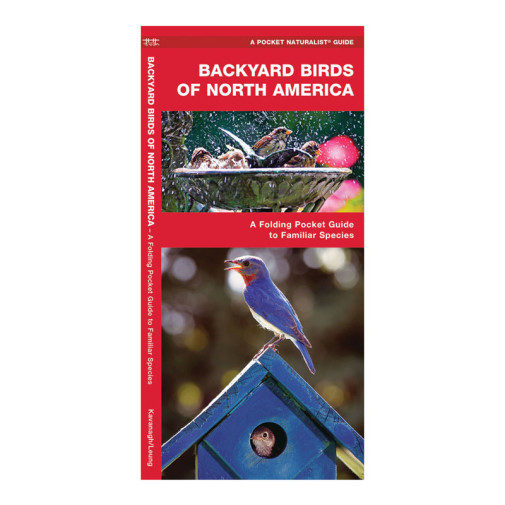We use cookies to make your experience better. To comply with the new e-Privacy directive, we need to ask for your consent to set the cookies. Learn more.
Backyard Birds of North America: Folding Pocket Guide to Familiar Species
With its compact size, detailed illustrations, and concise organization, this folding pocket guide to familiar North American birds is a perfect companion for backyard birders. The guide is split into categories of birds such as water birds, perching birds, birds of prey, etc. Each brief entry includes an illustration of the bird (both male and female if they differ dramatically), accompanied by name, scientific name, size, and often a brief notable characteristic. Also included are tips for attracting birds to your yard. 8.25" x 4".
It's easier than ever to go bird watching in your own backyard, especially during the spring and fall migration seasons. Backyard Birds of North America is the ideal pocket-sized, folding guide to help identify the birds at your feeder or those in migration. Clear, detailed illustrations highlight over 140 familiar urban species. This lightweight guide also provides the reader with instructions on attracting and feeding backyard birds. Created and printed in the USA, this guide was updated with a new cover design and laminated for durability. This is the perfect companion for both novice and expert bird watchers. Made in the USA
You wandered off too far from the campsite, miles from civilization. You're alone, lost, and hungry. As soon as you determine you are, in fact, lost, you decide to stop for the night, choosing a dry site near plenty of wood. Then you locate some nice dry wood, along with some dry birch bark tinder. After gathering armloads of wood, you build a teepee style fire and curl up near it, feeding it through the night. The next morning you devote your energy to building signs for others to find you, collecting water, and munching on edible plants you found growing nearby. Happily, you are soon rescued by a group of searchers. In your post-rescue interview, it was commented that you had made out pretty well for yourself, a person lost in the wilderness. You answer, "Well, it was really no big deal - after all, I did have my Wilderness Survival Pocket Naturalist to help me every step of the way." Enough said. These handy little laminated folding charts are so portable and convenient, they just have to come along on all your outdoor adventures. Folded up into 6 parts, printed front and back, these durable little guides are packed with information and illustrations with impressive depth. For example, in the abovementioned Wilderness guide, survival strategy, first aid, shelter, signals, water, fire, food, outdoor hazards, navigation, and several common animal tracks are all included. Whew! In the Edible Wild Plants guide, over 100 plants are described and illustrated for their usefulness, including plants used for nuts and seeds, fruits and berries, leaves, stems or bark, or roots and tubers, along with plants found in the desert, tropical area, or seashore. Dangerous poisonous plants are also included. With so much information in such a slim, easy-to-pack format, it makes it much easier to slip in that backpack than a set of bulky field guides. - Jess
| Product Format: | Other |
|---|---|
| Brand: | Waterford Press |
| Grades: | 5-AD |
| ISBN: | 9781583554647 |
| Length in Inches: | 8.25 |
| Width in Inches: | 4 |
| Height in Inches: | 0.0625 |
| Weight in Pounds: | 0.1 |

